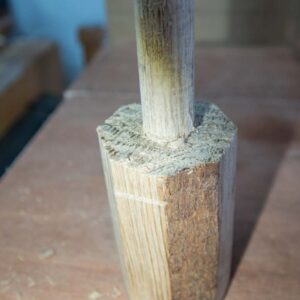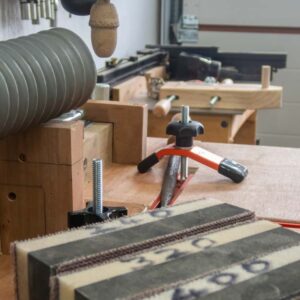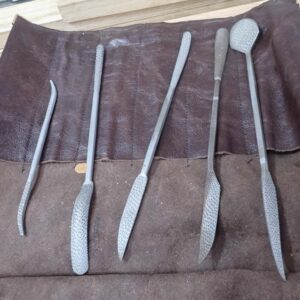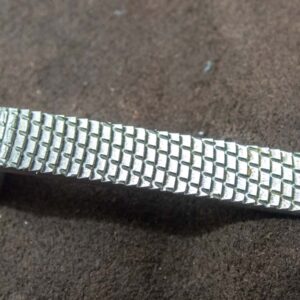Drill press “turning” experiments
Lacking the room to house a lathe in the workshop, the new drill press has adopted the role, at least for the making of knobs and other small parts. A FWW article from Christian Becksvoort shows a procedure for “turning” a Shaker knob with the drill press, using rasps, files and sandpaper as the turning tools.
https://www.finewoodworking.com/2014/04/01/how-to-turn-pulls-without-a-lathe-2
I’m just starting to make a small oak cabinet in the Cotswold Arts & Crafts style. It’ll have two drawers atop a leaded glass door cupboard. That needs two or perhaps 4 knobs for the drawers and one for the door.
Just lately I’ve been trying to make and use more wooden fittings, particularly knobs, handles and hinges. Acorn knobs for the above-mentioned cabinet seemed a good idea, so I’ve begun some experiments in drill press “turning” them, followed by a bit of simple pattern-punching to finish them off.
The results so far are moderately successful …. but more refinement of both shape and finish is needed – better technique, in other words; perhaps also different “turning” tools.
So I’d like advice and experience from any who’ve developed a drill press “turning” technique. What tools; what techniques?
As the pics show, getting the right shape is a matter of experimentation. None of the three acorns I’ve made so far are right but the middle one is getting there. It needs better proportions and a better finish, particularly to get rid of any around-the-circumference striations from the tools.
I started with a rough rasp to remove the bulk of the excess from the starting blank then went to finer rasps to refine the shape. Even the hand-stitched finer rasps tend to leave those striations around the circumference, though. It takes a lot of sanding to reduce or remove them.
Rougher sandpaper grits (60 -100 grit) leave striations of their own. Finer grits (up to 400 grit) take an age to take much off in removing the striations.
I did find that a Japanese float (see pic) works better than a toothed rasp to quickly remove material without leaving deep striations. The float teeth are more like small chisels or file teeth so don’t cut grooves like the rasps do. Files work too but are much slower.
**********
Anyroadup, if any drill press turners out there can give me any advice from their experience about how to best use what tools, I’d be very grateful. Meanwhile the acorn shaping experiments will continue.
Lataxe



















Replies
I like all three of those acorns as is. I don't see striations in the picture. When I drilled a knob on a hand drill, I used turning chisels. They scraped more than they sliced. The electric drill had a difficult time holding the end the knob and wouldn't take much pressure.
This forum post is now archived. Commenting has been disabled